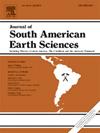Early Holocene climate transitions, fossil dinoflagellate cyst assemblages in the southern Gulf of California: Insights from the DIPAL IV core
IF 1.5
4区 地球科学
Q3 GEOSCIENCES, MULTIDISCIPLINARY
引用次数: 0
Abstract
This work reports on the variability of fossil dinoflagellate cysts and their relationship with climatic and oceanographic changes during the Early Holocene in the Alfonso Basin in the southern Gulf of California. The integrated palynological and geochemical analysis of 100 sediment samples from the DIPAL IV core provides information from 12.7 to 10.8 ka BP. The laminated sediments were dated using C-14 analysis and examined for concentrations of dinoflagellate cysts and continental palynomorphs, as well as content of total organic carbon, iron, titanium, and biogenic opal. The appearance of thermophilic dinoflagellate cysts at the beginning of the Early Holocene implies a warming trend, while changes in terrigenous input indicate fluctuations in precipitation and nutrient availability. Multivariate analyses revealed two distinct dinoflagellate cyst ecological intervals, accounting for over 65 % of the observed variance across the Younger Dryas–Early Holocene. This study shows how climate influenced both land and marine ecosystems in the Gulf of California during the Early Holocene, and the results deepen our understanding of paleoceanographic changes in the region and provide a foundation for future modelling of ocean productivity and algal blooms under climate change.
早全新世气候转变,加利福尼亚湾南部化石鞭毛藻囊组合:来自DIPAL IV岩心的见解
本文报道了加利福尼亚湾南部阿方索盆地早全新世化石鞭毛藻囊的变异及其与气候和海洋变化的关系。对DIPAL IV岩心100份沉积物样品进行了孢粉学和地球化学综合分析,获得了12.7 ~ 10.8 ka BP的沉积信息。用C-14分析测定了层状沉积物的年代,并检测了鞭毛藻囊和陆相苔藓的浓度,以及总有机碳、铁、钛和生物蛋白石的含量。早全新世初期嗜热鞭毛藻囊的出现暗示了一个变暖趋势,而陆源输入的变化则表明降水和养分有效性的波动。多变量分析揭示了两个不同的鞭毛藻囊生态间隔,占新仙女木-全新世早期观测方差的65%以上。本研究揭示了全新世早期气候对加利福尼亚湾陆地和海洋生态系统的影响,加深了我们对该地区古海洋学变化的理解,并为未来气候变化下海洋生产力和藻华的建模提供了基础。
本文章由计算机程序翻译,如有差异,请以英文原文为准。
求助全文
约1分钟内获得全文
求助全文
来源期刊

Journal of South American Earth Sciences
地学-地球科学综合
CiteScore
3.70
自引率
22.20%
发文量
364
审稿时长
6-12 weeks
期刊介绍:
Papers must have a regional appeal and should present work of more than local significance. Research papers dealing with the regional geology of South American cratons and mobile belts, within the following research fields:
-Economic geology, metallogenesis and hydrocarbon genesis and reservoirs.
-Geophysics, geochemistry, volcanology, igneous and metamorphic petrology.
-Tectonics, neo- and seismotectonics and geodynamic modeling.
-Geomorphology, geological hazards, environmental geology, climate change in America and Antarctica, and soil research.
-Stratigraphy, sedimentology, structure and basin evolution.
-Paleontology, paleoecology, paleoclimatology and Quaternary geology.
New developments in already established regional projects and new initiatives dealing with the geology of the continent will be summarized and presented on a regular basis. Short notes, discussions, book reviews and conference and workshop reports will also be included when relevant.
 求助内容:
求助内容: 应助结果提醒方式:
应助结果提醒方式:


